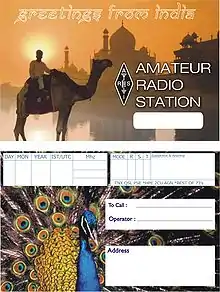Call signs in India
Call signs in India are unique identifiers for telecommunications and broadcasting in India. The Ministry of Communications and Information Technology regulates call signs nationally, and the International Telecommunication Union regulates call signs internationally.
Call sign blocks
The International Telecommunication Union has assigned India the following call signs:
| Callsign | CQ | ITU |
|---|---|---|
| 8TA to 8YZ | 22 | 41 |
| VTA to VWZ | 22 | 41 |
| ATA to AWZ | 22 | 41 |
Note: The Andaman and Nicobar Islands come under ITU Zone 49 and CQ Zone 26.
In addition to the above, the base of Maitri and the abandoned station of Dakshin Gangotri, also use the Indian callsigns but come under ITU Zone 67 and CQ Zone 38 respectively.[1][2]
Defunct callsigns
- CR8 – Portuguese India
- FN8 – French India
- AC3 – the former monarchy of Sikkim, now a state of India
Call signs

The International Telecommunication Union (ITU) has divided all countries into three regions; India is located in ITU Region 3. These regions are further divided into two competing zones, the ITU and the CQ. Mainland India and the Lakshadweep Islands come under ITU Zone 41 and CQ Zone 22, and the Andaman and Nicobar Islands under ITU Zone 49 and CQ Zone 26. The ITU has assigned to India call-sign blocks 8TA to 8YZ, VTA to VWZ, and ATA to AWZ.[3][4] The WPC allots the individual call-signs, or call sign series.
| Call-sign | Description |
|---|---|
| 2** | Callsigns used by early amateur radio operators before 1928. They were later converted to the VU series.[5] (defunct) |
| AT0 |
|
| AT*JCB | AT0JCB to AT9JCB – Special callsign allotted to mark the birth centenary of radio scientist Jagadish Chandra Bose in November/December 2007. See also AU*JCB.[6] |
| AT3 |
|
| AT6 |
|
| AT7 |
|
| AT8 |
|
| ATA |
|
| ATN | Antarctic expeditions[14] |
| AU*JSB | AU0JCB to AU9JCB – Special callsign allotted to mark the birth centenary of radio scientist Jagadish Chandra Bose in November/December 2007. See also AT*JCB.[6] |
| AU2BSG | Special Call Sign allotted for India's Second Scout Camp on the AIR (SCOTA) during 22–25 May 2015 at VU2HEN, Calvary Mount , Idukki, Kerala State, India. |
| VT | (Aircraft) |
| VU0 | Special call sign to celebrate the birth centenary of Mahatma Gandhi in 1969 |
| VU2 | General grade (Previously Grade I and Advanced Grade callsigns) |
| VU3 | Restricted grade (Previously Grade II and Grade II restricted callsigns) |
| VU4 | Special callsign used for an Andaman and Nicobar Islands DX-pedition in 2004 |
| VU5 |
|
| VU6 | Special callsign used by a broadcast station in pre-independence India |
| VU7 | Special callsign used by a DX-pedition in the Lakshadweep Islands in 2007 |
| VW | (Marine vessels) |
| CR8 | Portuguese India (defunct) |
| AC3 | Former monarchy of Sikkim (defunct) |
| FN8 | French India (defunct) |
Assignments for amateur radio
Amateur radio or ham radio is practised by more than 16,000 licensed users. The first amateur radio operator was licensed in 1921, and by the mid-1930s, there were around 20 amateur radio operators in India. Amateur radio operators have played an important part in the Indian independence movement with the establishment of pro-independence radio stations in the 1940s, which were illegal. The Wireless and Planning and Coordination Wing (WPC), a division of the Ministry of Communications and Information Technology, regulates amateur radio in India. The WPC assigns call signs, issues amateur radio licences, conducts exams, allots frequency spectrum, and monitors the radio waves.
See also
- Amateur radio in India
- Amateur Station Operator's Certificate
- Hamfest Celebrations in India
References
- Zone 67
- Zone 38
- ITU Zone 41 Map (Map). International Telecommunication Union. Retrieved 2008-07-23.
- CQ Zone 22 Map (Map). International Telecommunication Union. Retrieved 2008-07-23.
- https://web.archive.org/web/20080323154543/http://www.geocities.com/rf-man/ukcalls.html
- "Special callsigns for Acharya Jagadish Chandra Bose anniversary". Government of India letter "L-14011/640/ 2007-AMT" dated 2007-09-19". Southmate Amateur Radio Club. Archived from the original on 2013-04-15. Retrieved 2008-07-23.
- http://www.qrz.com/db/AT6MM
- http://www.qrz.com/db/AT7CD
- http://www.qrz.com/db/AT7LEO
- http://www.qrz.com/db/AT8LH
- http://www.qrz.com/db/AT8LHC
- http://www.qrz.com/db/AT8ESP
- http://www.qrz.com/db/AT8WFF
- http://www.users.waitrose.com/~bdxc/lists/itu/ind.html